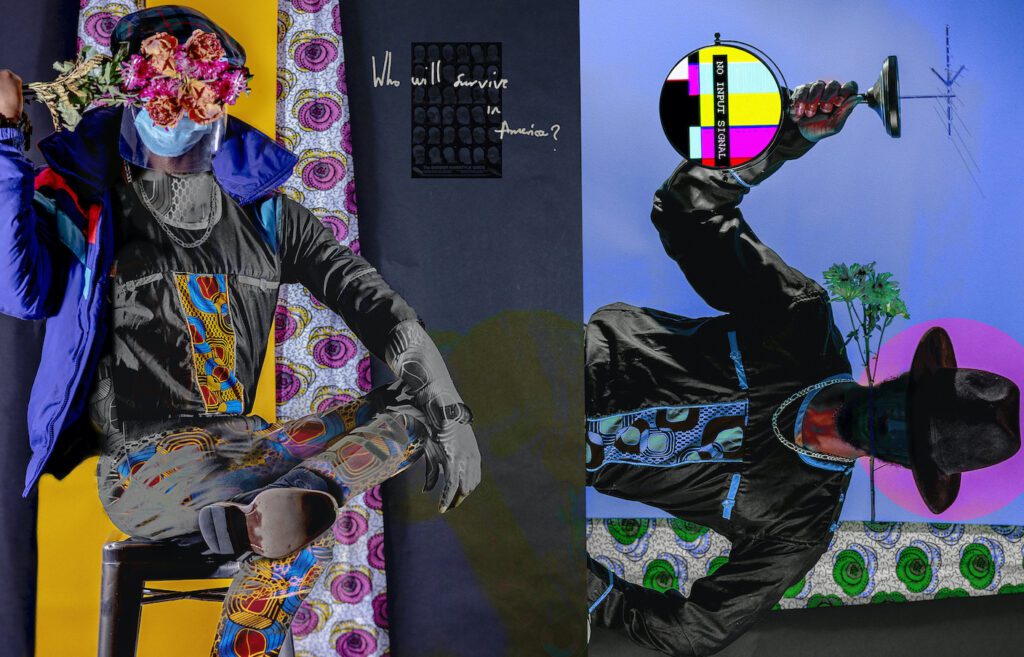The Africa Center, New York, United States
14 Oct 2022 - 02 Apr 2023

Gabriel C. Amadi-Emina, Fade Catcher (Detail), 2021
The Africa Center announces States of Becoming, an exhibition curated by Fitsum Shebeshe and produced by Independent Curators International (ICI) on view at The Africa Center at Aliko Dangote Hall from October 14, 2022 through February 26, 2023.
Artists: Gabriel C. Amadi-Emina, Kearra Amaya Gopee, Kibrom Araya, Nadia Ayari, Vamba Bility, Elshafei Dafalla, Masimba Hwati, Chido Johnson, Miatta Kawinzi, Dora King, Helina Metaferia, Nontsikelelo Mutiti, Yvonne Osei, Kern Samuel, Amare Selfu, Tariku Shiferaw, and Yacine Tilala Fall
States of Becoming examines the dynamic forces of relocation, resettling, and assimilation that shape the artistic practices of a group of 17 contemporary African artists who have lived and worked in the United States within the last three decades, and informs the discourse on identity construction within the African Diaspora. States of Becoming will be the first major contemporary art exhibition at The Africa Center since its transition from the Museum for African Art in 2013, and will be the first presentation of the touring exhibition produced by ICI.
The concept for States of Becoming evolved from curator Fitsum Shebeshe’s lived experience following his 2016 move from Addis Ababa, Ethiopia to Baltimore, Maryland and his subsequent firsthand knowledge of the weight of cultural assimilation. Confronted with a different society, Shebeshe encountered a wide range of existential questions that shaped his relationship to institutions and culture. Shebeshe also had the realization for the first time that he was viewed as belonging to a minority because of the color of his skin, and a newfound awareness of the profound impact Ethiopia’s traditional and conservative culture had on his personal sense of individuality.
Having found kinship among cultural practitioners from the African Diaspora who shared his experience, Shebeshe has united 17 artists with States of Becoming who either came to the United States over the past thirty years or who are first-generation born. The artists represented in States of Becoming relocated from twelve countries in Africa and one in the Caribbean–Ethiopia, Ghana, Ivory Coast, Kenya, Liberia, Mauritania, Nigeria, Senegal, Sierra Leone, Sudan, Trinidad and Tobago, Tunisia, and Zimbabwe–with roots in cities across the U.S., including New York, Washington, D.C., New Haven, Detroit, and Los Angeles.
Like Shebeshe, each artist in the exhibition has had a unique relationship to the U.S. context, which is reflected in their work. States of Becoming explores these artists’ perpetual process of identifying, redefining, and becoming themselves in both local and global contexts, opening up perspectives into multiple states both geographic and emotional in a constant flux of social and cultural adaptations. The exhibition presents work across mediums including painting, photography, sculpture, installation, and video, that express the many different ways in which identity is remade and reimagined. For instance, Nontsikelelo Mutiti looks to hair braiding salons of the African Diaspora, and Amare Selfu moves from figuration to abstraction to express transformation as a result of relocation. These distinct experiences produce a sense of hybrid culture emerging out of real and imagined genealogies of cultural, racial, national, and geographic belonging.
Although the individual artistic methodologies and experiences of the artists featured in States of Becoming vary, each seeks to reconceptualize a hybrid culture formed from real and imagined genealogies: cultural, racial, national, and geographical belonging. The exhibition is loosely arranged with three main categories: those whose aesthetic forms have undergone drastic transformations since migrating; those who desire to share the experiences and culture of their country of origin within the communities in which they now reside; and those who build bridges between the African diaspora and African American artists of their host country. By contextualizing these practices today, the exhibition provides a space to consider the intersections and contribute to the evolving discourse on relocation, resettling, assimilation, and identity construction.